| One More Tied Unit Weave |
Marcy Petrini
February, 2022
I will be presenting a seminar titled “An Eight-Shaft Primer of Tied Unit Weaves” at Convergence®, so I have been weaving tied unit weave samples.
My original intent for proposing the seminar was to review what I knew and to learn a bit more. But I am finding that the more I learn, the more I discover there is to learn.
First, I wove summer and winter on 8-shafts with its many treadling options. Here is a sheep from Strickler’s book A Weaver’s Book of 8-Shaft Patterns from the Friends of Handwoven (pg. 148):
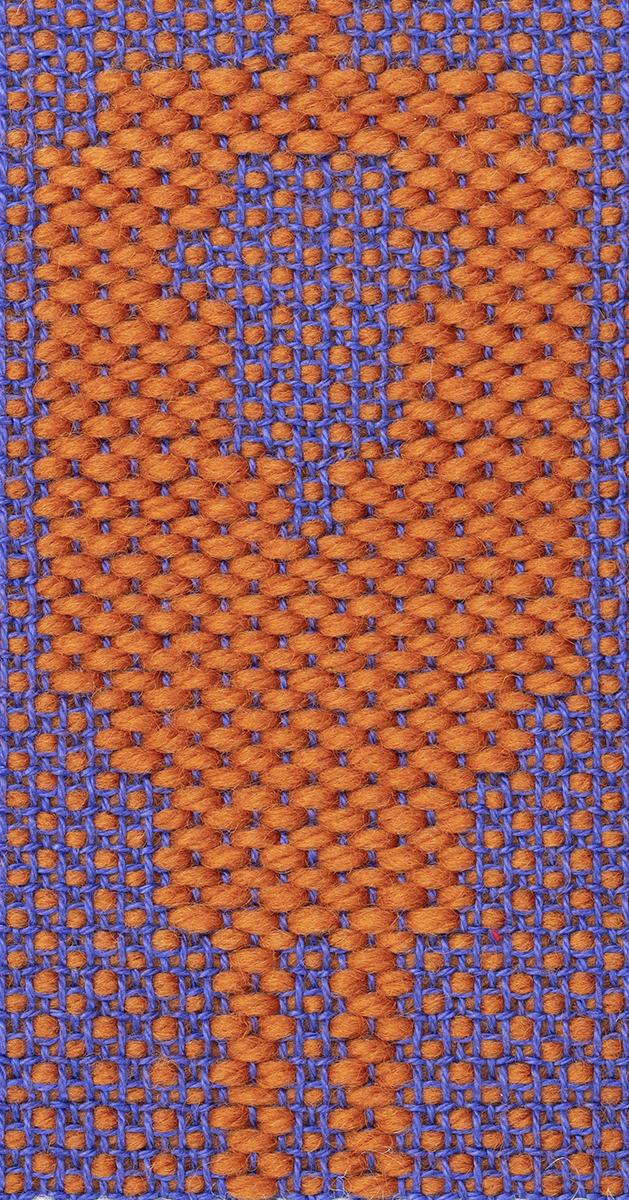
Next I went back to old favorites, for example Tied Lithuanian; then I tried structures I hadn’t woven before, for example half-satin.
Soon I realized how unhelpful those names are in understanding the structure. While Tied Lithuanian and Tied Latvian – different treadlings on the same threading – are at least descriptive of where they originated, half-satin is a deceptive name: satin is a simple weave by Emery’s classification, simple meaning one warp and one weft. tied unit weaves are compound structures, one warp, two wefts, specifically supplementary weaves, since the additional weft is not needed for the integrity of the cloth.
Some supplementary weft weaves, for example overshot, are inherently different from tied unit weaves; to differentiate them, Donna Sullivan in her book Summer and Winter, A Weave for All Seasons, uses the term supplementary weft patterning for tied unit weaves, because they generally form a characteristic stippled pattern, as seen in the sheep.
With this name confusion, I went back to Donna Sullivan’s classification which can be used for any number of shafts; using summer and winter as an example, here is how tied unit weaves can be described; unfortunately with more shafts, the nomenclature is not always unique:
|
Nomenclature |
Explanation |
Summer and Winter |
|
Single, double, etc. |
Number of pattern shafts per block |
One shaft of pattern per block, 3 for A, 4 for B, 5 for C, etc. |
|
# Tie shafts |
Number of shafts for the tie down threads |
Shafts 1 & 2 |
|
Paired or unpaired |
Whether the ties are next to each other (paired) or not |
Shafts 1 & 2 are separated by the pattern shaft |
|
Ratio |
Tie-down threads to pattern threads within a block |
For each tie down thread, there is a pattern thread |
Thus, summer and winter is a single, two tie, unpaired with a ratio of 1:1 structure. We can abbreviate to single, unpaired two-tie, 1:1.
Below is the drawdown, using sinking shed and showing only the pattern weft. In weaving we alternate each pattern shot with a plain weave shot, treadled 1 & 2 vs. 2 & 4. The reason for using a sinking shed is because we think of “weaving a block” as covering it with weft. When the warp lowers, the weft floats over it, making the connection between shafts and blocks easier to see.
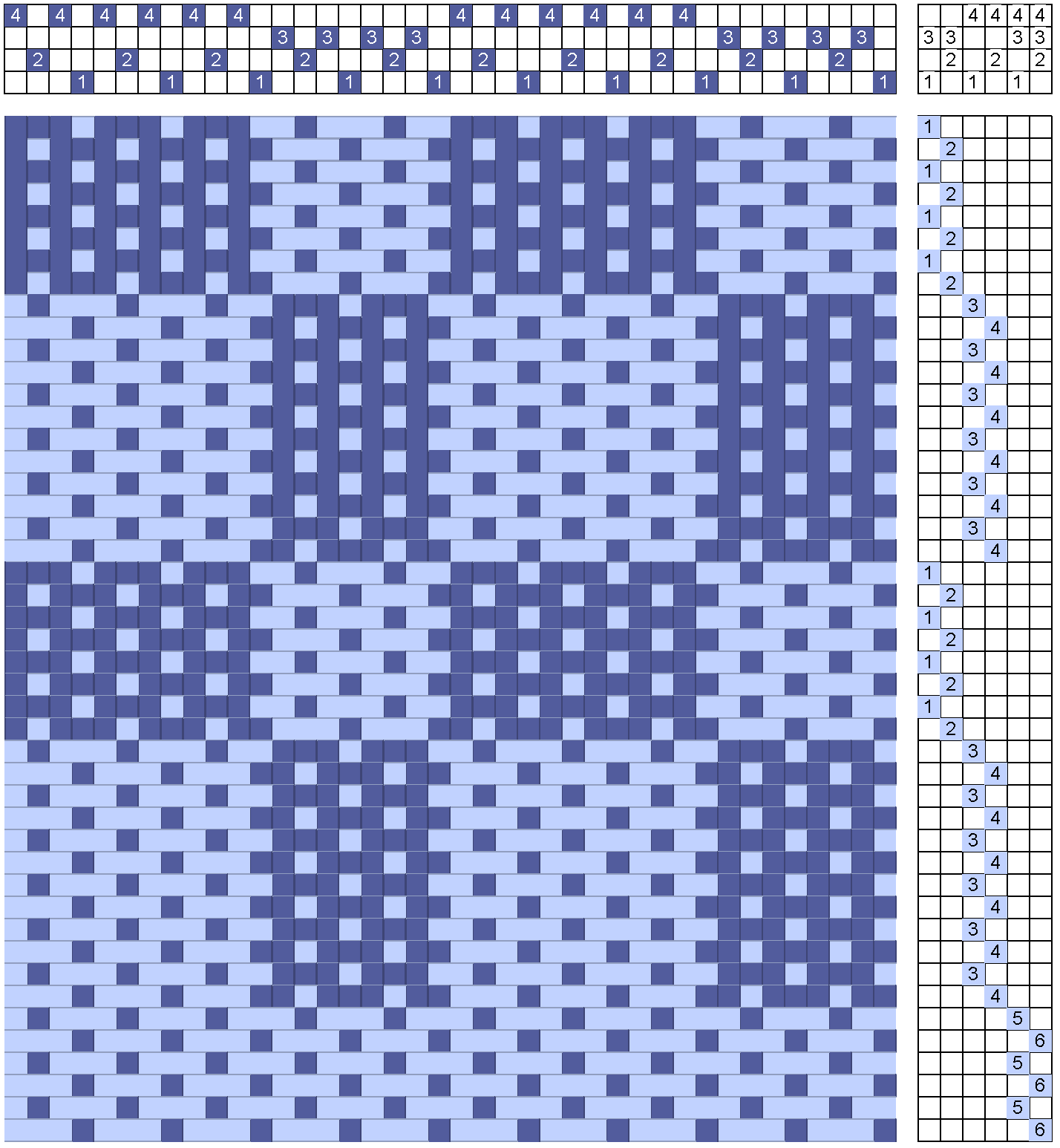
The drawdown shows the features of tied unit weaves. The first distinguishing characteristics is that the threading of each block is fixed, the ties limit the floats, so blocks can be repeated adjacently. In the above draft for summer and winter, block A is repeated 2 times, block B 3 times. When we look at the drawdown, the blocks are seamless, just different in size, but the weft floats are never longer than over three warp ends.
The second distinguishing characteristic, this shared with all unit weaves, is that blocks can be treadled together. This is shown at the bottom of the drawdown, but it is also seen in the sheep motif. This characteristic of combining blocks in treadling is a powerful design option, especially when we expand to more shafts, as seen in the sheep.
Bronson Lace is a unit weave, but not tied, even though at first glance, shaft 1, shared with all blocks, makes it appear that it is a tie. The drawdown below shows that shaft 1 acts as a tabby and the floats in the blocks are delimited by shaft 2, the other tabby.
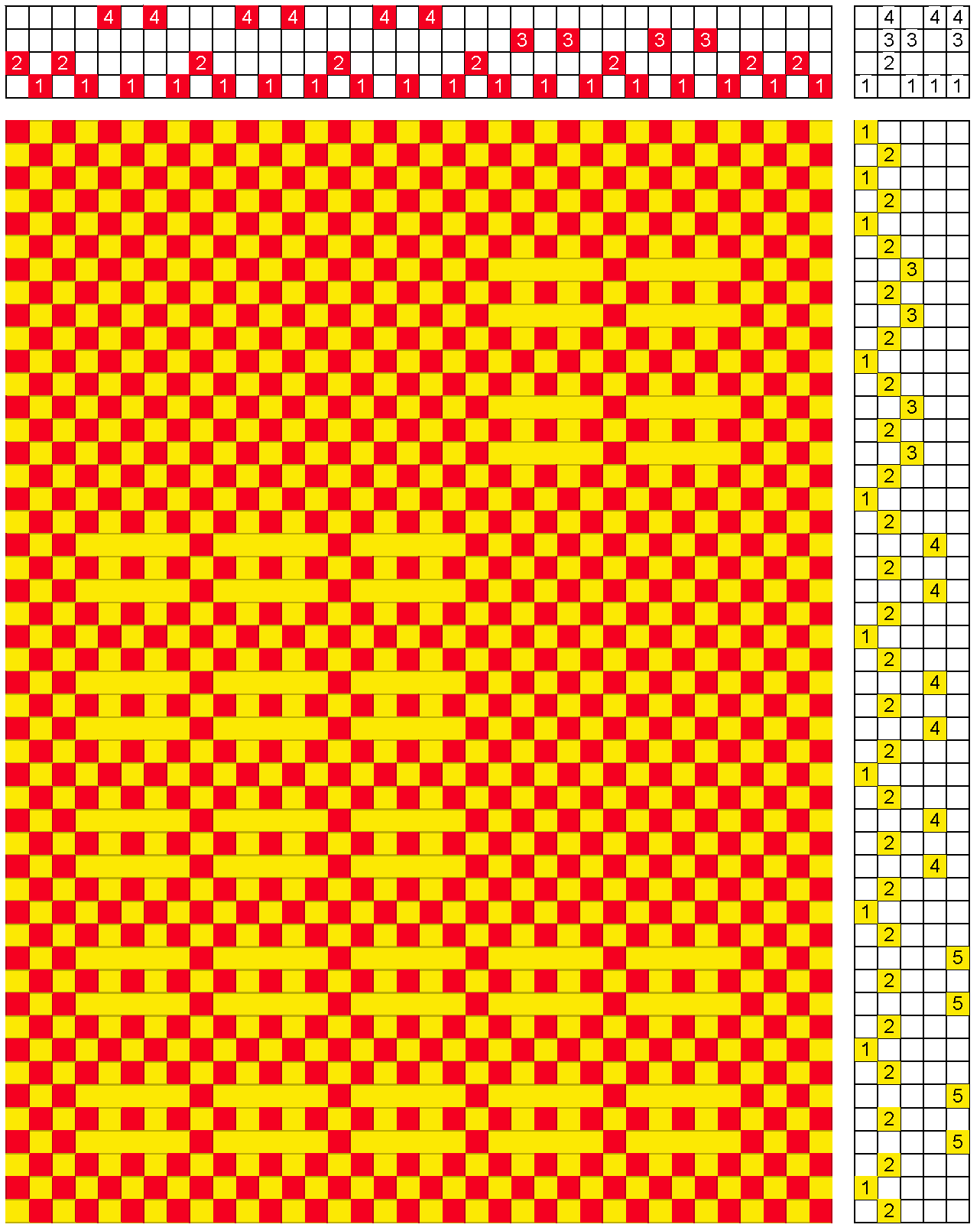
Blocks can be combined in the treadling, shown at the bottom of the drawdown. But to repeat blocks they have to be separated by shaft 2, while in summer and winter the blocks are adjacent.
Once I clarified the classification, I decided to look at the possibilities in a methodical way and see which structures I had not woven yet.
Summer and winter – single, unpaired two-tie, 1:1 – is the simplest of unit weaves and can be woven on four shafts. If we look at the nomenclature, we know we couldn’t have blocks with less than a single shaft! But from the above discussion about the difference between tied unit weaves and unit weaves in general, we know that we need at least two ties for a structure to have fixed blocks.
The next logical step to me was to change the other parameter: single, with two paired ties. I didn’t find that option where I looked, certainly not an exhaustive search, but it is easy enough to determine what it should be.
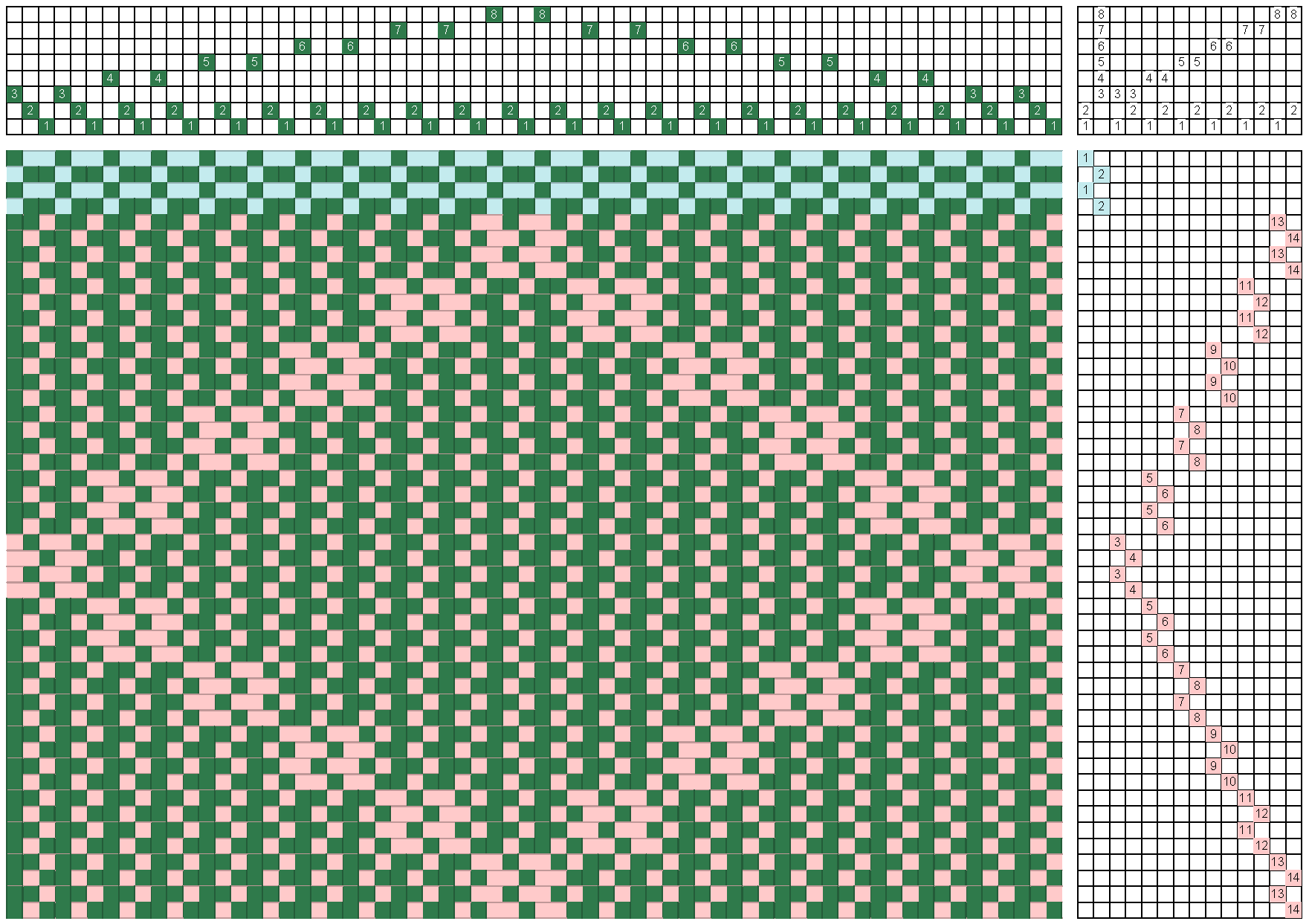
The ratio is 1 pattern thread for 2 two ties, so the structure is: single, two-ties, paired, 2:1 ratio.
Because the block is small, I doubled each one for my sample; I threaded the 6 blocks in pointed order and wove diamonds as shown in the drawdown.
For the treadling, I added a pattern shaft to each tie and treadled the blocks in that order, as shown in the draft. This is a common way to weave tied unit weaves.
As with all other tied weaves, a ground thread alternates with the pattern thread. The top of the drawdown shows the treadling steps for the ground, which is not plain weave, but a pseudo basket weave. This is not unusual, other tied weaves have grounds that are not tabby.
Here is the front of the sample, green warp and ground weft, off-white pattern weft:

And here is the back:

As written in the draft, the treadling requires 14 treadles, but I wove it on a loom with 10 treadles using two feet. The ground required 2 treadles, the tie down shafts 2 more, and the pattern blocks 6. My loom is also a rising shed, so in order to weave each block, I had to raise all other shafts, that is, to weave block A which uses shaft 3 in the threading, I had to lift all pattern shafts but 3. Below is the actual drawdown for my sample.
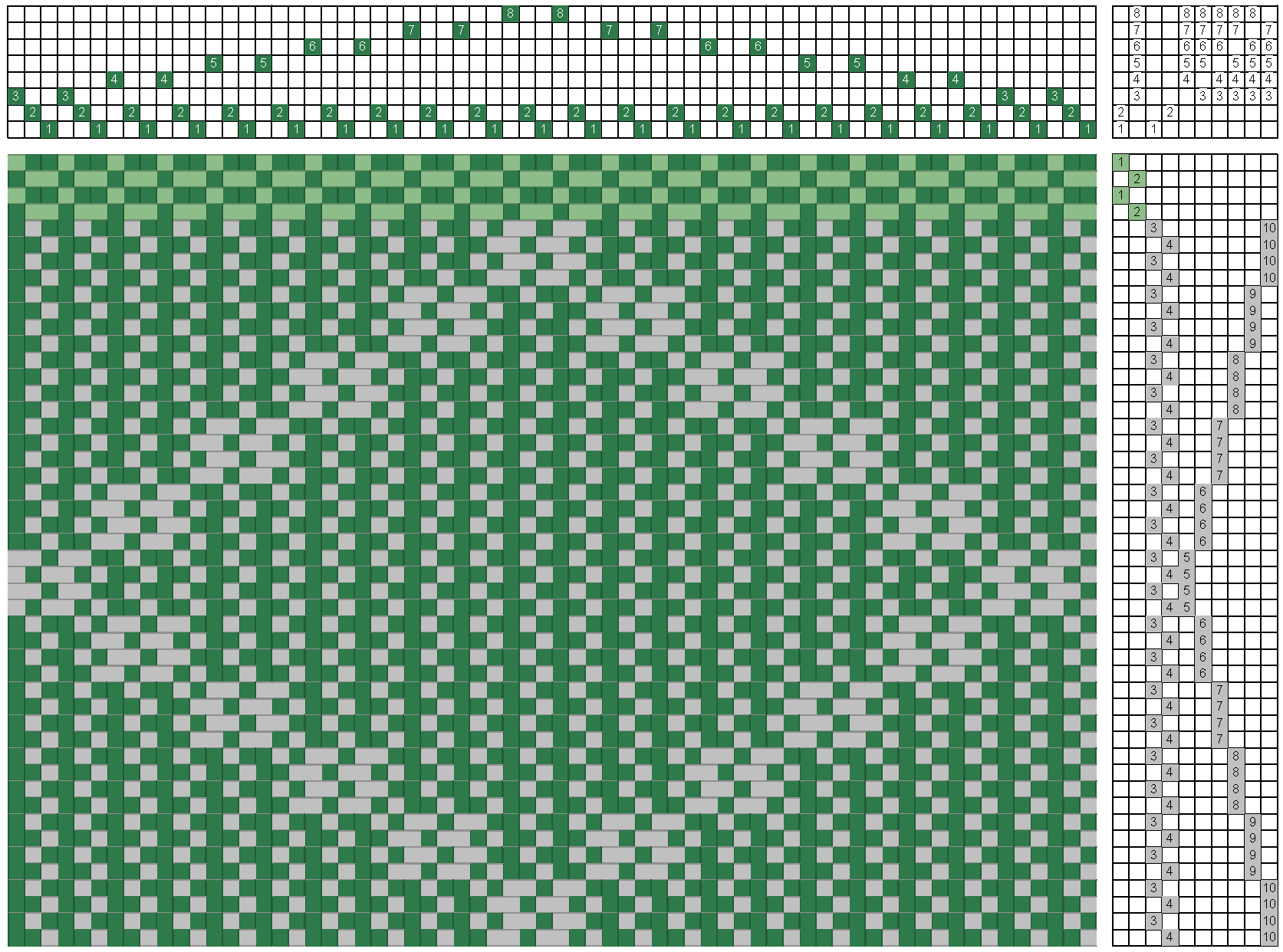
The possibilities for tie weaves are many: more than one pattern shaft, more than two ties, and once we increase either number, there are a variety of ways that the shafts can be arranged. For example, the tie unit weave called Bergman –single, three tie, unpaired, 1:1 – uses 3 ties, arranged in a 3-shaft birds’s eye twill, while another by the same nomenclature, uses a pointed twill.
If you want to learn more, come to my seminar at Convergence®, I would love to see you there!
Happy weaving!
Marcy
| A Shaded Twill |
| — and — |
| The Year Ahead |
Marcy Petrini
January, 2022
At the beginning of the year, I like to take some time to recap my weaving for the past year and to look forward to the coming year.
There are two reasons as to why I like to look back: I am always surprised at how much I have actually woven; weaving is just part of my fiber work, I also write and teach, on zoom during this pandemic time. So, seeing the list of pieces and samples that were finished during the year gives me a sense of accomplishment.
The other reason is to ask myself where am I headed with this work: am I happy to stay the course? Do I need to find a new direction?
With Convergence® on the horizon, this past year has been full of sampling for the seminars I will be presenting. I like to either weave new samples or expand the selection; in 2021 I have been sampling rectangular float weaves, including unit weaves, and tied-unit weaves, a total of 10 sampler warps.
I wove 5 pieces that were part of my COVID-19 series all of which I have documented in blogs on this website and, together with the 2019 COVID-19 pieces, were assembled into a booklet which we mailed to family and friends in lieu of a holiday card in December 2021; below is the cover of the booklet.

A few more things were woven: 3 shawls on the AVL and 2 sets of napkins because my husband often remarked that he felt like the shoemaker’s child – no shoes. We now have some nice and serviceable napkins.
With this overview, it’s time to think ahead. I am in the process of organizing the samples to see what else I may want to weave for the seminars and the monographs that I will have for Convergence®. Below is one of the tied-unit weaves samples, single, 3 unpaired ties, 1:1 ratio (a single pattern shaft per block, 3 shafts for ties which alternate with the pattern shaft resulting in a 1:1 ratio of pattern threads to tie threads). Two more samples are in the works already and another in the planning stage. I am sure there will be more. I will re-assess that part of my weaving after the conference.

I haven’t decided about the COVID-19 series. Frankly, I thought we would have moved on from COVID-19 by now. After the delta scarf, described in the December 2021 blog, I was thinking of weaving something for the “new normal” as I described in the December blog. I hadn’t even gone past that thought that omicron arrived….. I decided to take a break from COVID-19 weaving and think about what next.
I needed some comfort weaving, but with a bit of a challenge to keep things interesting: I decided that I would weave a twill I have never woven before and use yarn from my stash, at least one of which had to be a yarn I had never used before.
The yarn was easy. When HGA was closing its on-line store, they had a few skeins of a variety of Convergence® yarns that they were selling deeply discounted, so I bought the very last remanence. I received several skeins of my favorites – and 4 skeins of 10/2 rose Tencel®. There is nothing wrong with the rose color skeins, but as a child I had a rose color dress made of silk taffeta that I just hated, the rustling drove me crazy. So, the rose color skeins have languished in my stash for a few years. That yarn had to be used, even if in small amounts. Here is the yarn wound into a ball, ready for use!

Meanwhile, I was leafing through Davison’s book for twills. The “shaded twill” on page 51 caught my attention. The drawdown below shows that it is composed of stripes of a simple undulating twill and basket weave. I could thread the basket weave section with the rose Tencel®.

I planned on 5 sections of the undulating twill separated by 4 sections of the basket weave. I looked at a few 20/2 silk yarns for the twill, since 10/2 Tencel® and 20/2 silk is a combination I have often used successfully. I settled for a yellow green for the outside twill sections, a bluish green for the next 2 sections, and a variegated silk for the middle section. I sett the entire warp at 24 epi and I adjusted the number of ends so that I could have an 8” scarf. Floating selvages were not needed since the pattern started and ended with a straight will.
Next the weft. I thought a green silk may work, but the pattern disappeared; I tried yellow, but it overwhelmed the scarf – a little yellow goes a long way, but an entire weft is too much. I settled on a cinnamon color 10/2 Tencel® also from the Convergence® batch, which I had used before. The After Image of the cinnamon yarn is a pale bluish green, making the blue-green warp more noticeable.
The complete scarf is the first project off any of my looms this year:

And here is a close up. The undulating portion is a bit unstable, so a warp sett of 28 epi would probably have been better, but the scarf is usable.

It’s time to go back to sampling…..
Have a healthy and safe 2022 and I do hope to see you at Convergence®!
Happy Weaving!
Marcy
Delta: Covid Strikes Back
Marcy Petrini
December, 2021
As I write this, it’s mid-December 2021, and in Mississippi we are in the second wave of the Covid-19 Delta variant, with the variant Omicron on the horizon.
But the scarf that I wove for the Delta was during the first wave, starting in August and continuing through September. Just as we were enjoying our newfound cautious freedom, the pandemic, instead of retreating, was ramping up again.

The virus mutates and the more viruses there are around, the more the chance of mutations.
And with a high percentage of unvaccinated, there are a lot of viruses around.
Sadly, vaccinated people with confounding medical conditions are dying.
But most of the cases and deaths occur in the unvaccinated; they chose “freedom” over their fellow men. The virus has freedom to choose too, and it strikes back with Delta.
The scarf was a way for me to deal with the frustration. Here is a close up:

As I was thinking about the scarf, I knew I would choose red for the Delta; when I saw the first drawing of the virus back in early 2020, it was depicted in red, and since then, when I think of the virus, “I see red.”
Because vaccination is so helpful, I didn’t want the warp to be totally black; breakthrough infections, as they are called, are usually a mild disease. So, I wanted a warp ranging from off white to black, maybe different size stripes.
A more distinct Delta could be obtained with more shafts, but my 4-shaft floor loom was ready for a warp, so the design would have to be on 4 shafts. I always say that limitations enhance creativity. A pointed twill threading was the obvious choice. To make the pointed twill stand out, I would weave bands of the twill in red, alternating with a neutral color, maybe one of the warp yarns.
To make the individual deltas separate, I abbreviated the treadling and separated each row of twill with plain weave. As I was working with the drawdown, this thought occurred to me: “with this pandemic, we don’t know if we are coming or going (coming down or going up in cases)”. So, I decided that the half the Deltas would be up, the other half down. I tried a few combinations, and finally settled on four rows on one direction, and four in the other direction, with plain weave separating the sections as well as the rows.
Here is the final drawdown:

I removed the usual 1 & 2 treadling step to separate the delta motifs; three shots of plain weave separate the 4 rows of pointed twill, nine separate the rows of pointed twill motifs from the 4 rows of reverse pointed twill motifs.
Meanwhile I was working on my yarns. A beautiful hand painted silk, black and greys from Jems Luxe Fibers, approximately 1,000 yards/lb. was perfect for the warp and for the non-red sections weft of the scarf. For the red I found in my stash a Henceforth Yarns 100% silk 4/2 spun, dyed red by Neal Howard.
While the yarns are a bit heavier than may be ideal for a scarf, because it is 100% silk, the scarf does drape well.
As I was finishing the scarf, as the case numbers were finally decreasing again, I read about an interview with Dr. Robert Wachter, the chair of the medicine department at the University of California, San Francisco who suggested that for people with a booster shot, this may be the “new normal”: masks, social distancing from people whom you don’t know are vaccinated, and other similar precautions. I could live with the “new normal”, all of my friends are vaccinated. Maybe my next weaving should be the “new normal”. Of course, experts caution, all bets are off if we get a new variant….
Happy Weaving!
Marcy
Take Me Out to the Ball Game!
Marcy Petrini
November, 2021
In 2020 Major League Baseball cancelled all Minor League games. But in 2021 our M-Braves were back! The Mississippi Braves are the AA Affiliate of the Atlanta Braves.
Being outdoors, baseball games were an activity approved for controlling the virus. Alone or with friends, we were regulars at Trustmark Park.

Even though the team didn’t play its best early on, it was wonderful being back; after all, the grass is greener, the sun shines brighter and the beer tastes better at the ballpark! But the M-Braves improved through the season and won the AA Southern League Championship.
Going to the ballgames, I would sing to my husband:
Take Me Out to the Ball Game!
Imitating Carly Simon, but not very well.
One day, as we were driving to the ballpark, I thought: I should celebrate by weaving a scarf!
As I talked about in my October blog, I had been thinking about linen weaves in Davison’s book, and I thought that the one in the canvas weave chapter would be the perfect structure to depict a baseball. However, I had to modify the draft because I didn’t want the canvas blocks to be throughout the fabric or even staggered in columns.
Meanwhile I was thinking of colors: green for the grass and white stripes for the ball. I could change the drawdown to get a mixture of plain weave and pseudo-basket weave for texture, as ballparks usually have a variety of grass cuts Here is the drawdown:
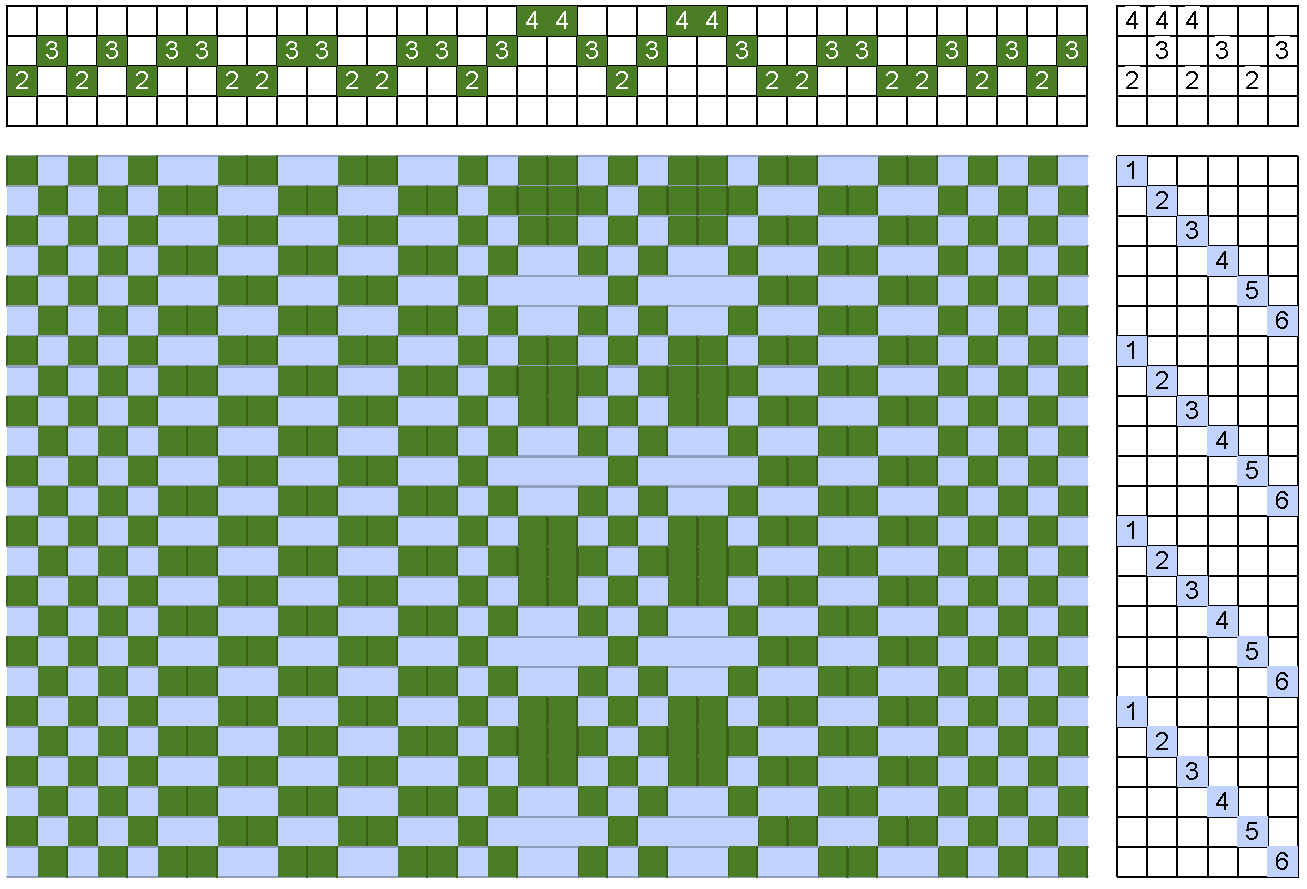
Looking at it, I realized that I could use the middle thread on a shaft 2 for a red stripe. Because there is a single thread, the stripe wouldn’t be solid, but alternating warp and weft – perfect for the stitching on the baseball!
But a green fabric with white stripes, even with the red stitching, wasn’t very exciting. I started thinking about the colors of ballpark – infield is brown!
As a baseball field, the scarf didn’t have to be symmetrical. As I was working with the proportions of the colors and the structures, I had an idea of where to place the white stripes:
a foul ball
a bunt
an infield hit
and a line drive!
I used 20/2 silk for the green, brown and red; to make the white stand out more, I used 8/2 silk.
Finally, it was time to weave; using the green of the warp for weft made the fabric somewhat flat. I tried a variety of green yarns, and found that a 10/2 Tencel®, color sage, worked well.
Here is the Take Me Out to the Ball Game scarf and close-up.


By the time the scarf was done, the season was over. But that’s OK, I wouldn’t be wearing a silk scarf to a ballgame with 100 degrees weather!
Happy Weaving!
Marcy
Linen Weave
Marcy Petrini
October, 2021
In the September / October 2021 issue of Handwoven, Judy Steward reviewing Shanta Eri silk for the Yarn Lab article, shows an example of “Linen Weave”. I had not thought about “linen weave” in decades, I remembered it as a textured weave, which Judy’s sample also shows.
I came across linen weave at a time when I didn’t really understand weaving classification of any type, so everything seemed to be a weave of sorts – linen weave, waffle weave, boundweave, etc.
Judy referenced Davison’s book in her article, so I had to look up linen weave. There are four entries for it in Marguerite Porter Davison’s book, A Handweaver’s Pattern Book. Judy’s version of the book is the 1944 edition, mine 1994, so I didn’t know exactly which of the four linen weaves Judy used. Time to explore.
The first linen weave is in the Canvas Weaves chapter, one threading with three treadlings (see drawdown below in the same order as in Davison). If we look at the third treadling, we see why this linen weave is in this chapter, it is a double block canvas weave. I decided it to adapt for a current project I am weaving which will be for a later blog.
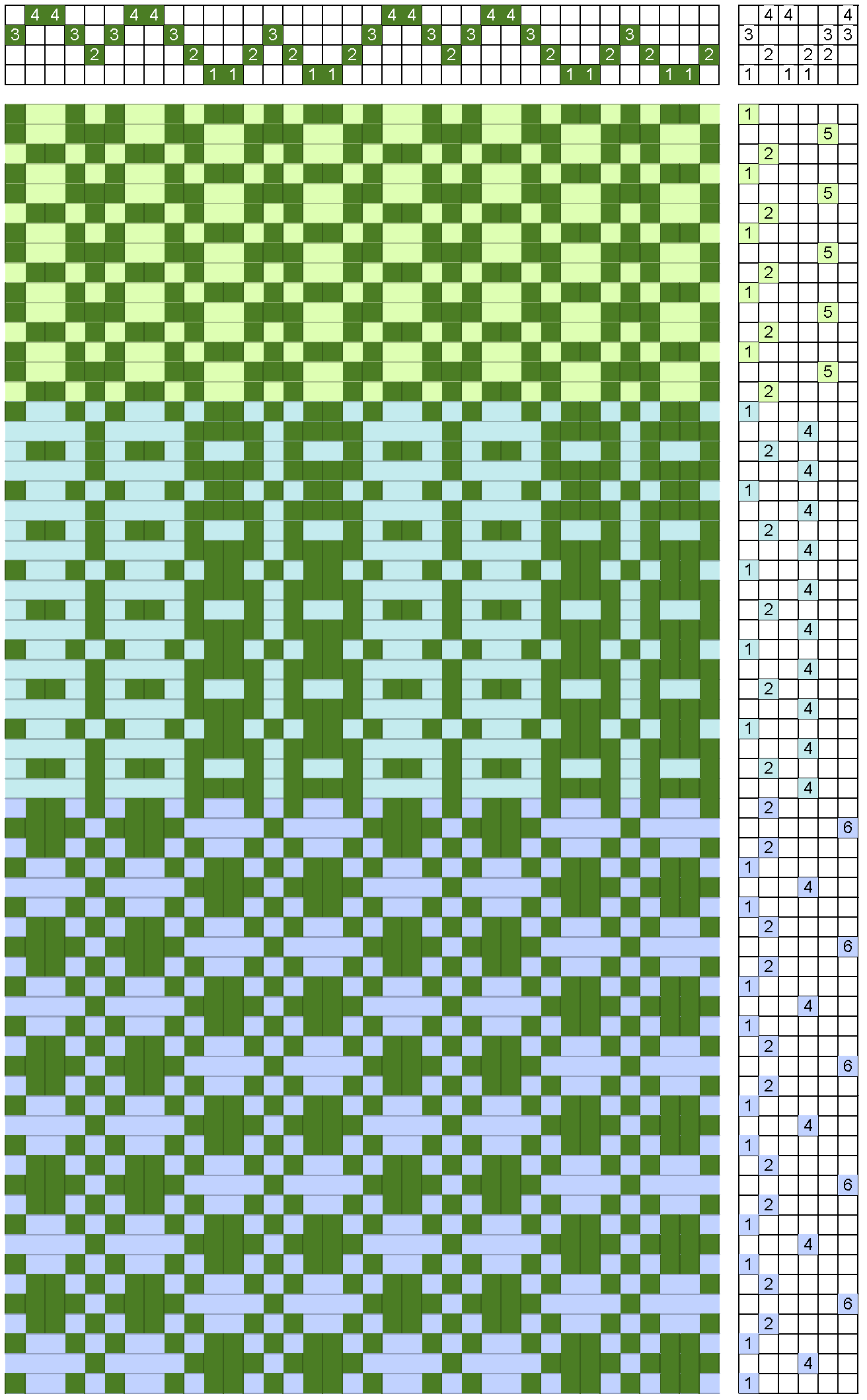
The other two treadlings form columns of warp-dominant and weft-dominant stripes, accentuated by the sleying of cramming 4 threads in one dent, and then leaving one empty.
The second reference of linen weave in Davison’s book is by Caroline Halvorsen’s No 180, in the Texture Weaves chapter, Judy may have used this one for her sample, hard to tell from a small photograph. Looking at it, I realized that it is twill blocks, two blocks on four shafts. The threading is similar to the twill blocks I have used before, the entry for which is in the Pictionary©, but the treadling produces more pronounced differences, the blocks are more warp or weft dominant. Below is the drawdown; this, too, is a structure I would like to try. There are relatively long floats, 5-threads, but they contribute to the warp or weft dominant look.
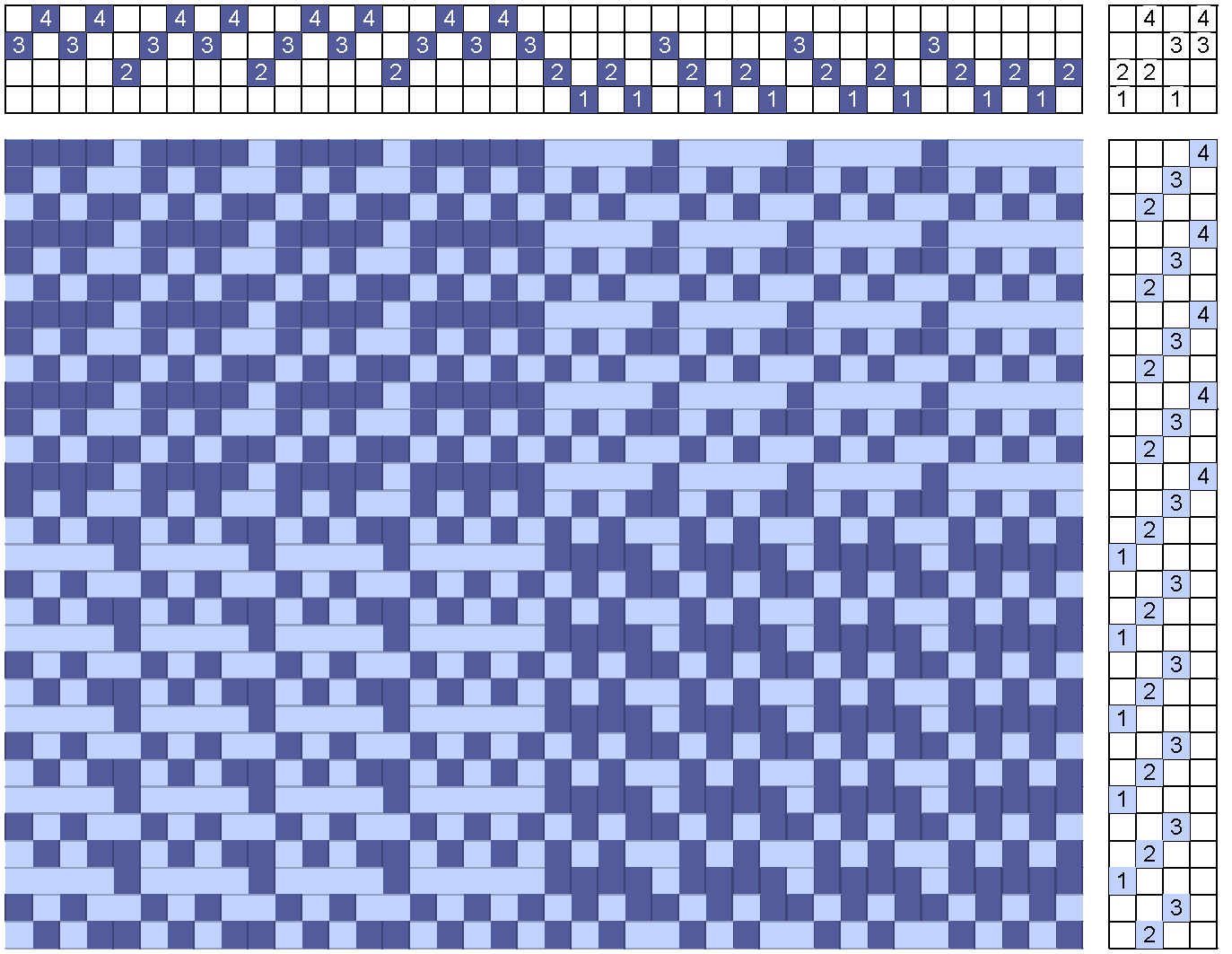
The next two linen weave examples are from the chapter called Thousand Flowers; Davison says that “All of the patterns given in this chapter are four-unit overshot weaves…” Confusing terminology since overshot is not a unit weave.
The first sample, Linen Weave Unit has two treadling options, one with tabby and one without. The drawdown for the one woven with the tabby is below:

The second without a tabby is next:

The final example is called Linen Weave Plaid; it has two blocks, block A is the same threading as the Linen Weave Unit, the second block B is inverted. Block A is repeated 5 times, then to form the “plaid”, there is a block B, block A, block B. The thread on shaft 1 is omitted when the following block is different. The treadling uses a tabby. In the drawdown below I used 3 repeats of block A threading and treadling to make it more easily seen.

Even though Davison says that these structures are overshot weaves, I was intrigued by the Linen Weave Unit. Could it be woven as a unit weave? From the threading, it appeared that it could be classified as a double (2 pattern shafts per block), two tie (1, 2), unpaired (ties not next to each other) with a ratio of 1:4 (1 thread on a tie shaft for every 4 pattern threads). It could be easily expanded to more shafts for more blocks, three on 8 shafts, A, B, and C.
The treadling could be the classical way: the two pattern shafts for each block with each tie-down thread; that is, to weave block A, we would treadle: 1 & 3 & 4 vs. 2 & 3 & 4. Here is the drawdown, the first repeat shows the units, the second repeat shows how it is woven with the alternating tabby:
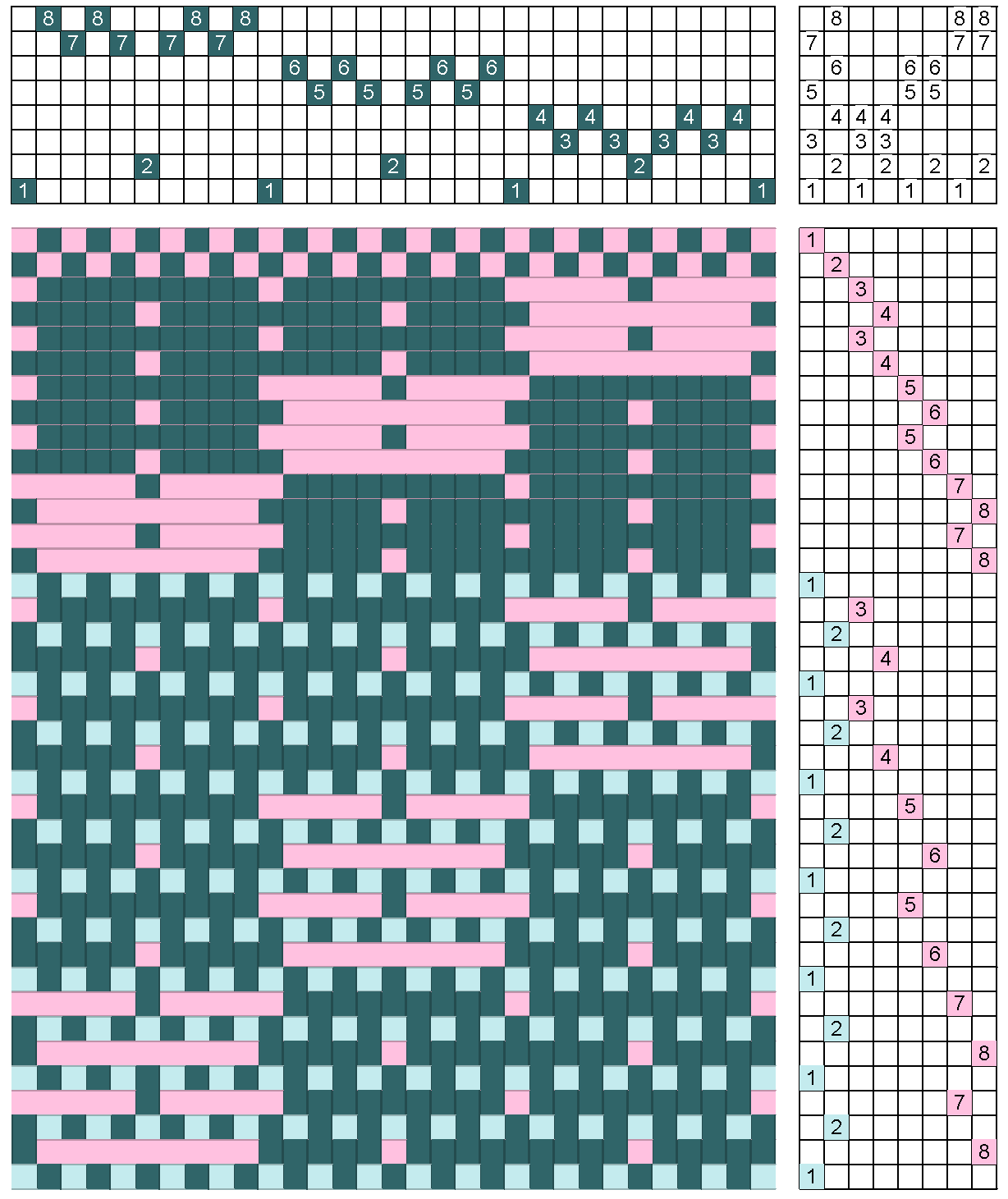
It can, in fact, be woven as a unit weave. As I looked at the drawdown, it looked awfully familiar. Because I was scheduled to lead a seminar on unit weaves at Convergence 2020 – and now moved to Convergence 2022 – I have been exploring and weaving unit weaves. I went back to my notes and there it was!
Below is the front of double, two unpaired ties with a 1:4 ratio, followed by the back of the sample:


This unit weave is sometimes called 4:1 Beiderwand. However, Donna Sullivan, in her book Summer and Winter A Weave for All Seasons, explains why she does not like the beiderwand designation for unit weaves because true beiderwand is a double weave cloth, with two warps and two wefts. Madelyn van der Hoogt has written a nice explanation of beiderwand in her “Ask Madelyn” column of November 24, 2015 (https://handwovenmagazine.com/doubleweave-part-2-beiderwand-and-lampas).
Happy Weaving and Exploring!
Marcy
